For the previous 20 years the rise of the web and technological development have modified our lives drastically. From each day climate test, information studying and communication to training and work – there’s nearly no side of our life that may keep untouched by the facility of the web. The reason being apparent, the web makes our lives simpler, simplifies our mundane routines and easily saves lots of time. Furthermore, the unfold of the web went hand in hand with the development of applied sciences, particularly smartphones which led to such unavoidable outcomes as transferring some elements of our lives into the web world.
Certainly one of these facets is procuring, which has reworked for the final couple of many years considerably. If beforehand individuals needed to go from store to buy with the intention to buy even probably the most primary requirements and spend hours on it, now all of the retailers are only one click on away whether or not you need to order meals or buy clothes. Moreover, retailers even personalize their product supply particularly for each buyer taking into consideration their shopping for expertise and preferences, saving much more time for shoppers. On high of that, they add further reductions or coupons for ordering on-line, ship ‘thanks for procuring with us’ presents and supply particular gives for loyal prospects. Subsequently, prospects save each money and time and have their purchases delivered proper to their doorstep prefer it’s Christmas day by day.
As an increasing number of individuals desire on-line procuring, the e-commerce enterprise is increasing quickly. It’s predicted that within the upcoming years the worldwide e-commerce market will develop to unprecedented numbers reaching USD 26.59 trillion by 2027. The driving drive behind the expansion of on-line procuring is growing adoption of digital applied sciences, altering client habits and the speedy growth of web entry worldwide. One of many essential roles in e-commerce is performed by so-called social commerce which growing recognition is decided by elevated utilization of smartphones for shoppers’ each day duties and on-line procuring.
So, what’s social commerce and the way is it completely different from on-line procuring? Social commerce is a type of e-commerce that takes place on social networking web sites reminiscent of Instagram, Fb, X (previously Twitter) and others. Services are promoted and bought on these networking web sites the place individuals may also touch upon them, put likes, share and repost them. Entrepreneurs additionally use completely different techniques to advertise their merchandise/companies and make advert campaigns extra profitable. A few of them embrace utilizing movies, user-generated content material, hashtag advert campaigns, collaboration with celebrities and influencers, gamification and interactive video adverts (IVA) produced by Multiplayer Agency which is without doubt one of the current techniques utilized in social commerce. So, let’s look how social commerce grew to become so widespread and what position gamification is taking part in in it.
Let’s start with on-line procuring and its rising recognition amongst completely different teams of individuals worldwide.
There are over 2.14 billion online shoppers on the earth and, in response to the numbers offered by Statista, world retail e-commerce gross sales reached practically 6 trillion U.S. {dollars} and is projected to proceed rising over the approaching years. By the yr 2027 it’s anticipated that the numbers will develop 39 % and surpass 8 trillion {dollars}.
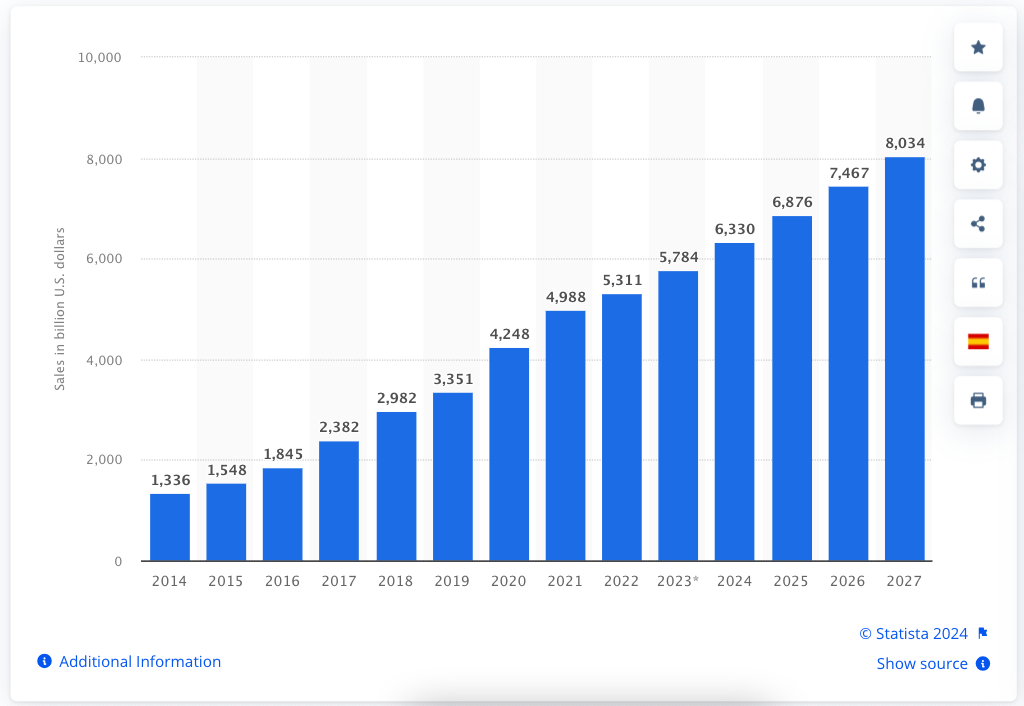
These numbers point out that the recognition of on-line procuring is undoubtful and, taking into consideration how spectacular the numbers are, extra enhancements and developments may be anticipated within the e-commerce sector.
At present it’s troublesome to seek out an individual who has by no means ordered something on-line and there’s intensive analysis and research explaining what the explanations for this phenomenon are. However even simply taking a look at our client expertise we are able to see that the principle two causes for this are comfort of on-line procuring and unprecedented utilization of smartphones.
As indicated within the report “The Subsequent Billion Customers: A Quick-growing Alternative for Digital Commerce” offered by Accenture, shoppers globally now desire on-line procuring as a result of wider product choice, higher pricing and general comfort.
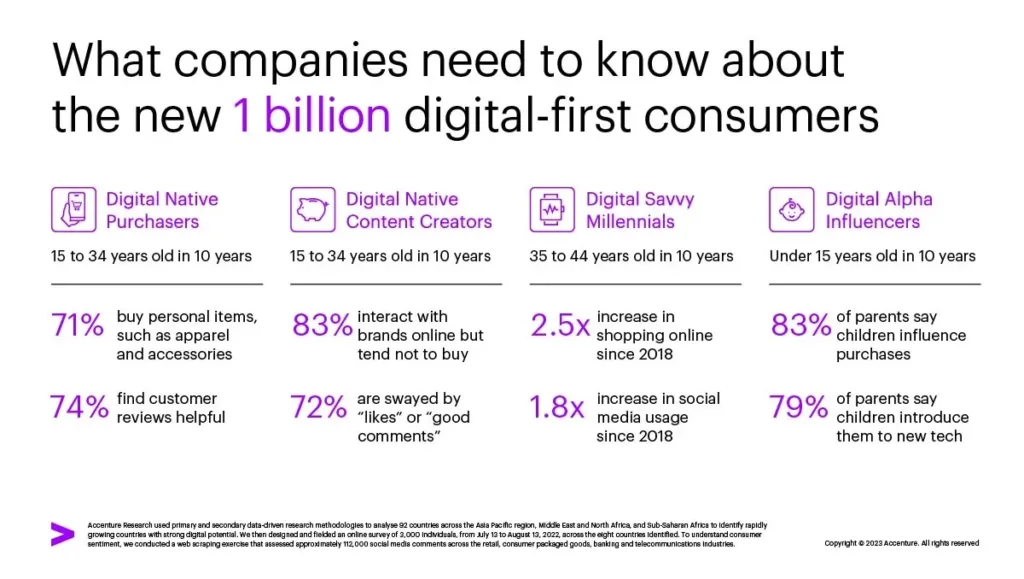
Furthermore, 80% of surveyed shoppers indicated that they use completely different on-line channels reminiscent of social networks, serps and different on-line companies to analysis merchandise earlier than shopping for them. Moreover to purchasing on-line, individuals are additionally influenced to purchase merchandise by social media and different on-line platforms. 76% of respondents admitted that ‘likes’ and ‘good feedback’ on social media affect their shopping for selections.
Apparently, cellular units are taking part in a vital position in on-line procuring now although they had been thought of not more than a wi-fi gadget for connection simply 20 years in the past. Nevertheless, now nearly all of the inhabitants worldwide can’t think about their each day life with out a smartphone. In relation to procuring, in 2023 over 70 percent of all retail web site visits all over the world are accounted for by smartphone customers. It vividly demonstrates that smartphone integration into procuring will proceed shaping the procuring expertise sooner or later.
Yet one more necessary issue within the unfold of on-line procuring is the impact that social networks have on individuals. On a regular basis individuals spend hours on Instagram, Fb and different platforms, see dozens of adverts and posts by influencers utilizing some services or products. This content material naturally creates a sense amongst people who they should “sustain with the Joneses”. 40% purchases are made as a result of individuals had been influenced by social media although they could have in all probability not even thought of shopping for something.
The presence of enterprise on-line can also be underlined by the truth that 63% of procuring events start on-line, whether or not or not the buyer finally ends up making their buy on-line or in-store.

Subsequently, having services offered on completely different platforms together with social networking web sites shouldn’t be solely useful by way of establishing on-line presence, but additionally necessary for capturing prospects’ consideration through the earliest phases of their procuring journey.
We will see that the event of smartphones, web and social networking web sites is a match made in heaven that naturally led to the creation of social commerce and its spectacular development. For a few years now we have witnessed that commerce goes to ‘probably the most crowded locations’ – from newspapers, to TVs, to web sites, to social networks, making an attempt to get the eye of as many individuals as potential. So, it’s not a shock that such platforms as Fb and Instagram which have billions of customers worldwide grew to become the following huge factor on the earth of on-line procuring.
Social Commerce – Subsequent Large Participant?
In keeping with a report by Straits Analysis and verified by Statista, the income of social commerce across the globe has reached $913 billion for the previous yr and is predicted to develop by 31.6% a yr reaching $6.2 trillion by 2030.
Social Networking Websites – a Bridge Between Clients and Commerce
Essentially the most widespread platforms for social commerce are Instagram, Fb and TikTok the place the overwhelming majority of manufacturers can current their services and use the platforms in response to their wants.
Instagram gives quite a few instruments that may considerably increase the web presence of a enterprise and result in a extra satisfying buyer expertise. As a substitute of clicking the hyperlinks and looking for the specified merchandise on an internet site, prospects can straight entry it for the time being of discovery as a result of interactive clickable content material.

Merchandise can be tagged in posts, tales and adverts, making the entry to them simple and offering a secure checkout.
Fb has comparable functionalities to Instagram on account of being owned by Meta. Outlets may be discovered on the enterprise Fb web page, in posts and tales the place the merchandise are tagged. Customers can save the merchandise they favored and even proceed with checkout with out leaving the app.
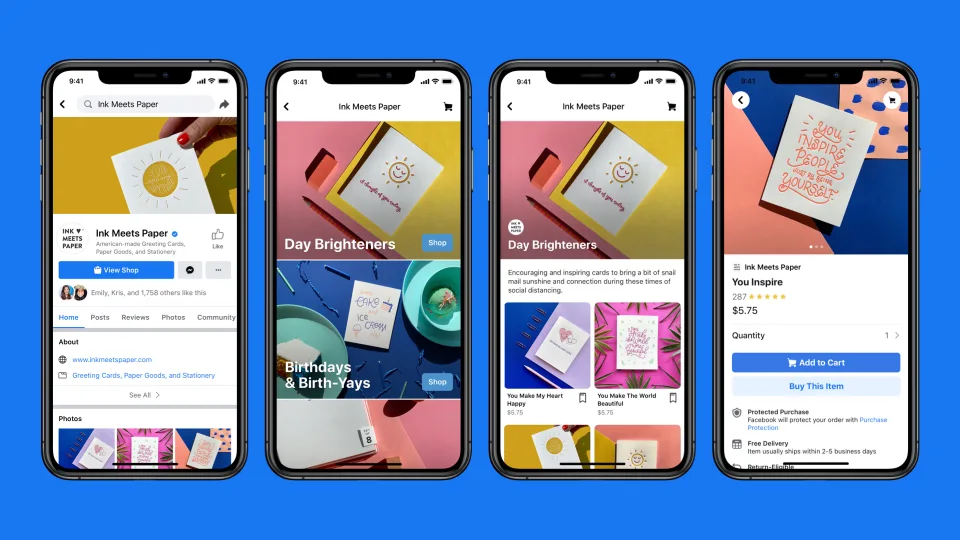
TikTok took one step even additional in social procuring offering each prospects and sellers with quite a few helpful and efficient instruments.
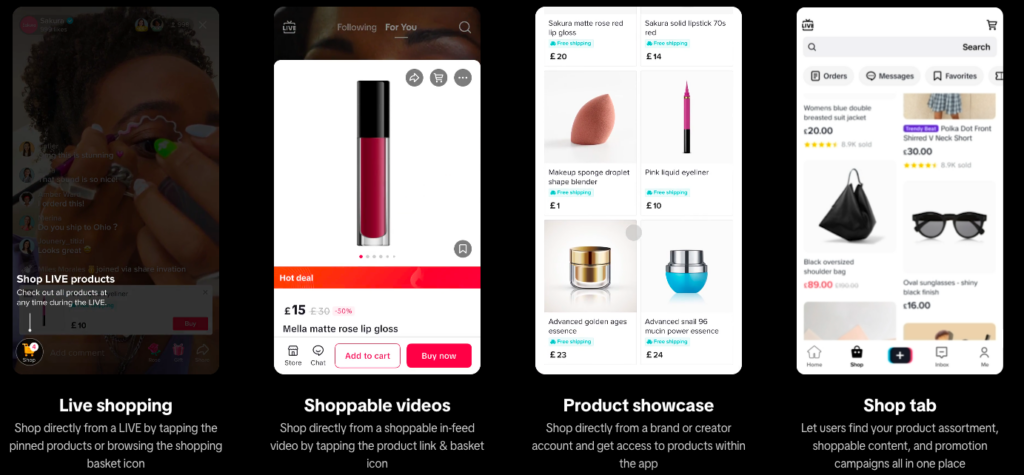
They supply probably the most seamless integration of merchandise into the content material of the app with out disrupting the general person expertise. On the one hand, customers can benefit from the content material they like with out being bombarded with infinite unskippable adverts. Alternatively, customers inquisitive about discovering new merchandise can simply discover them on account of built-in merchandise, shoppale movies and interactive adverts.
Driving Forces of Social Commerce
However what are the driving forces behind the social commerce that makes it take over the world? Market specialists underline a number of necessary elements that push social commerce income to such highs.
Firstly, because it has already been talked about above, the technological development allowed shoppers to have entry to their favourite services proper by means of their smartphones making prospects simply a few clicks away from the products they want. The variety of smartphones is presently round 5.25 billion all over the world and rising. So, so far as the traits go, there isn’t a doubt that social commerce will maintain rising together with it reaching $3.44 trillion by 2027. Nevertheless, it isn’t solely about having a smartphone, it’s concerning the period of time that customers spend on cellular units. In keeping with numbers, within the US alone, each day individuals spent nearly one hour extra in 2023 than they spent 4 years in the past. Whereas in 2019 on common customers had been spending 225 minutes day by day on smartphones, it elevated by nearly 23% by 2023.
After all, a considerable period of time is dedicated to looking by means of social community platforms. As of 2023, the variety of social media customers has elevated to a file 4.9 billion users worldwide.
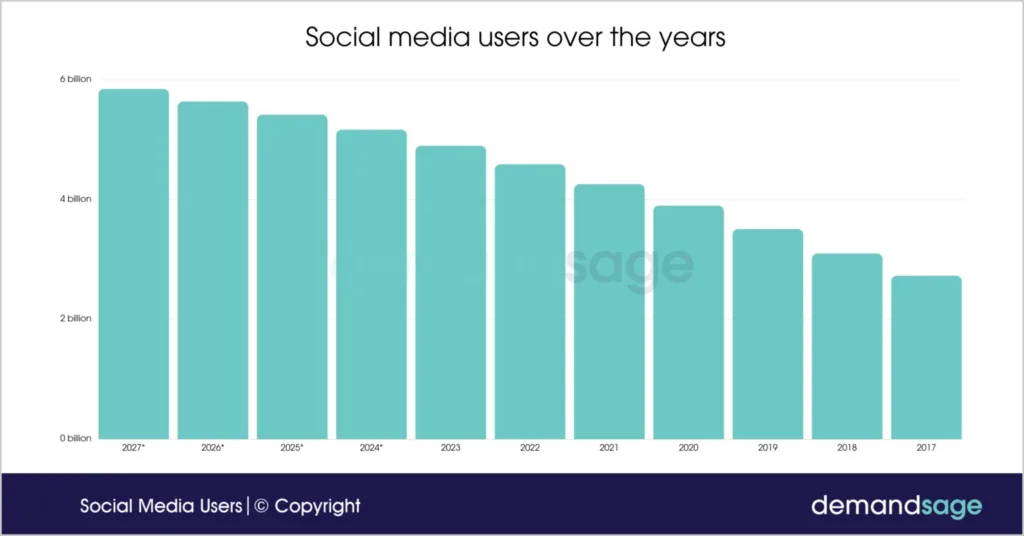
What’s extra, these customers will not be tied to a single platform solely, their digital footprint spreads throughout six to seven platforms a month. That’s the reason we are able to see the growing multi-platform advertising bombarding, turning social networks right into a one-stop store.
Unsurprisingly, social networks are taking their fair proportion of consideration in the case of commerce. On high of that, it created the entire business of influencers, product placement and advertising tips with the intention to give you the best method to promote services. Although social commerce is a comparatively current phenomenon, it has already gained important belief amongst shoppers. Thus, 50% of millennials place their religion in social media influencers’ suggestions and 88% highlighted their appreciation of authenticity they’ll discover in critiques on social media platforms.
As for the manufacturers’ house owners, the chances that social networks supply are astonishing. The mix of social interplay, sharing, commenting, studying who’s utilizing what and the flexibility to show social indicators into potential e-commerce conversions is bringing on-line procuring to a model new stage.
The Attract of Gamification in Social Procuring
Gamification arrived to the advertising and e-commerce area as the reply to the principle challenges that entrepreneurs and sellers had confronted. Although the abundance of on-line retailers and the simplicity of the procuring course of appear to drive extra gross sales, there are some issues that make sellers search methods to keep away from them and maintain prospects . Among the challenges embrace:
Deserted Carts
In keeping with the Baymard Institute, the typical documented on-line procuring cart abandonment fee is 70,2% which constitutes about $260 billion value of misplaced orders.
Model Loyalty
It’s comprehensible that customers all the time attempt to discover the very best gives with the intention to buy the products for a greater worth. Subsequently, manufacturers and retailers present quite a lot of reductions and particular gives for his or her prospects, so switching from one model to a different that provides higher choices is a totally regular client habits. Nevertheless, from the manufacturers’ perspective, such habits is a problem, as a result of luring new prospects is each money and time consuming. It prices 5 times more to amass a brand new buyer than it does to retain a returning one. Furthermore, loyal prospects spend 43% extra money on their favourite manufacturers. Subsequently, retaining prospects is yet one more problem that’s very important for on-line commerce to deal with.
Clients consideration
Because it has been talked about above, the abundance of manufacturers, retailers and merchandise brought about the problem to draw the eye of shoppers. Considering that on common an individual is uncovered to 4 thousand ads a day, it’s inconceivable to anticipate that folks will attentively scrutinize every of them. Subsequently, discovering the methods to make a model stand out is a major problem that firms should overcome to succeed.
Subsequently, we are able to see that gamification parts are being utilized an increasing number of with the intention to deal with the widespread points that manufacturers face. Although we are able to see some gamification parts within the bodily world, reminiscent of an interactive brochure of a automotive firm Peugeot, the actual energy of gamification grew to become obvious with the development of smartphones and web applied sciences. Gamification gave a begin to the unfold of such environment friendly advertising techniques as loyalty applications, reward techniques, interactive challenges, limited-time gives, flash gross sales, augmented actuality (AR) experiences and others. Let’s have a look at them a bit nearer.
Loyalty Packages and Reward Techniques
Loyalty applications and rewards are highly effective instruments within the arsenal of manufacturers as a result of variety of benefits they provide to prospects. Firstly, they supply individuals with monetary advantages: they’ll buy items and companies with reductions or particular costs. Secondly, it impacts the general buyer expertise, as a result of it makes prospects really feel part of a much bigger group giving them an necessary feeling of belonging. 81% of consumers agree {that a} loyalty program membership influences their chance of constructing a purchase order. Furthermore, it’s useful for manufacturers not solely by way of gross sales, however by way of understanding their prospects’ buying habits, thus, making their gives simpler. The checklist of firms that supply prospects loyalty applications is lengthy together with such manufacturers as Starbucks, Sephora, Mac, Nike and others.
For instance, Sephora’s ‘Beauty Insider’ loyalty program gives their prospects with particular gives, factors assortment, recognition and particular titles for achievements.
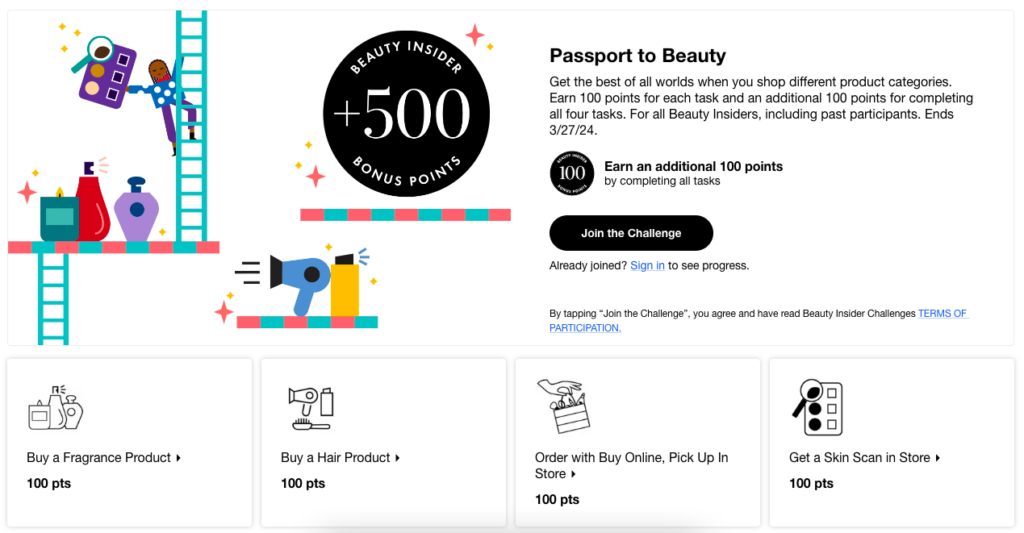
In 2023 they began using the total energy of gamification creating challenges to encourage members earn extra factors. Duties embrace on-line and offline actions in addition to non-purchase duties.
Total, such gamified expertise engages prospects, makes them extra inquisitive about following model’s gives and information, will increase general interplay with a model leading to higher brand-customer relations.
Livestream Procuring
Livestream procuring first appeared in China in 2016 as an try of a well-known Chinese language platform, Alibaba, make prospects extra concerned within the Single’s Day procuring.

The thought of livestream procuring is much like the applications broadcasted on TV the place a number would show merchandise and all people might name and order it. Nevertheless, like something you switch from TV to digital, the interactive choices are a lot broader: customers can click on on a product and purchase it, ship feedback and reactions, ask questions and be an lively participant of the livestream. Liveshopping had an amazing success in China and demonstrated spectacular outcomes. For instance, in 2020, the primary half-hour of Alibaba’s Singles’ Day presales marketing campaign on Taobao Dwell generated a powerful $7.5 billion in complete transaction worth. It vividly illustrated the facility of constructing prospects lively members of the procuring expertise telescoping their journey from discovery to buy. As for the main classes of livestream procuring, unsurprisingly, they’re the merchandise that may be simply demonstrated reminiscent of attire and trend objects.
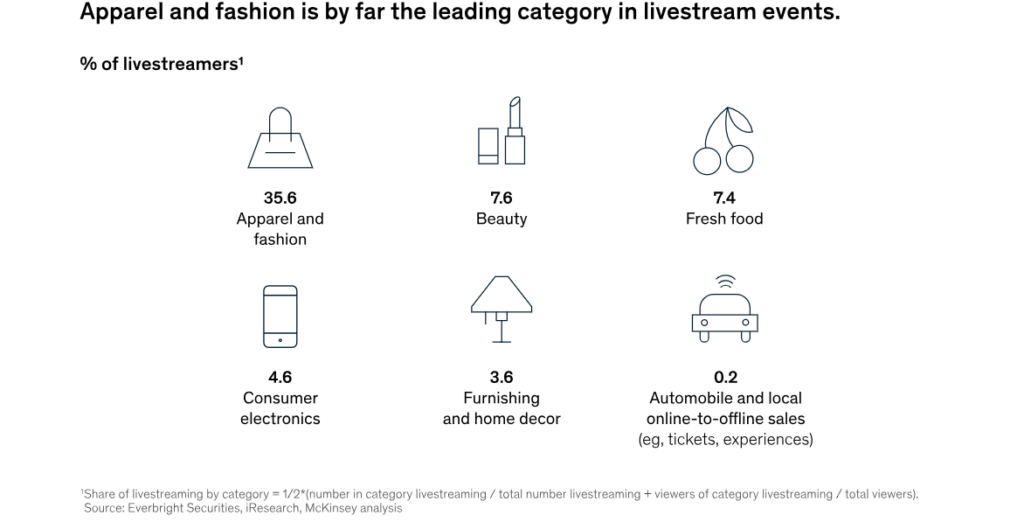
After such an amazing success, livestreaming was destined to unfold to Western nations and shortly after such social networking platforms as Instagram and Tiktok began engaged on including this perform to their platforms. Although Meta has not too long ago stopped liveshopping, they proceed to supply livestreaming device that manufacturers and influencers can use to attach with their prospects and promote merchandise.
For instance, widespread fast-fashion retailer, Shein frequently conducts livestreams offering prospects with the knowledge on the most recent traits, demonstrating merchandise and discussing them within the dwell stream. Clients can watch it on such social platforms as Instagram, Youtube, Fb and others and obtain bonus level and reductions for participation.
However not solely huge manufacturers depend on the facility of dwell streaming, small companies additionally profit from the increase that livestreaming can present because the income stream. A pre-owned designer purses enterprise known as Bagriculture is one among them.

When studying about livestreaming the CEO of Bagriculture determined to switch his enterprise from bodily to digital world. Whereas bodily retailers had been making $100 thousand, livestreaming allowed them to succeed in a broader viewers and generate $100 thousand a day. By livestreaming at a number of platforms concurrently, the enterprise might set up higher connections with prospects by answering their questions and demonstrating merchandise, thus, offering increased high quality buyer expertise and reaching new prospects on the similar time. “All of the metrics exceed another type of procuring I’ve seen – interval,” Velez, CEO of Bagriculture, stated.
TikTok can also be one of many social platforms that creates and gives instruments for commerce development. Considering that on common a TikTok person spends 858 minutes per thirty days on the app, it represents a profitable alternative for companies to be a focus for a considerable variety of customers, particularly amongst Gen Z.

In December 2020, Walmart and TikTok partnered to pioneer a novel shoppable dwell stream expertise for the U.S. market. This collaboration, concentrating on the wonder phase, yielded spectacular outcomes, showcasing the potential of dwell commerce to interact audiences and drive gross sales.
The preliminary dwell stream occasion exceeded expectations by 700%, garnering considerably increased views than anticipated. Moreover, Walmart’s TikTok follower base witnessed a exceptional 25% development, demonstrating sturdy viewers engagement and model consciousness.

Capitalizing on this success, Walmart hosted a second dwell stream occasion, the “Spring Store-Alongside: Magnificence Version,” in March 2021. This iteration featured famend magnificence influencer Gabby Morrison alongside different creators, providing an interactive expertise brimming with contemporary product suggestions and shoppable tutorials.
The occasion showcased a various choice of nationwide, personal, and Black-owned magnificence manufacturers, catering to a wider viewers. Viewers gained useful insights by means of product demonstrations and trend-focused make-up, skincare, and haircare routines. The seamless procuring integration inside the TikTok platform facilitated on the spot product purchases, enhancing the general expertise.
Together with dwell streaming , TikTok gives quite a lot of extra choices for companies. They are often entitled to being probably the most superior networking platform by way of enterprise instruments and buyer expertise. They’re one among not many platforms that supply interactive and gamified instruments for manufacturers which embrace:
- Dwell procuring provides;
- Interactive add-ons;
- Dynamic showcase buttons;
- Name to motion buttons and lots of extra.
Subsequently, by offering companies with these artistic and environment friendly options, TikTok will increase the opportunity of prospects visiting a bodily retailer by 350%, shopping for a product – by 150% and visiting an internet site or app – by 40%.
Augmented Actuality (AR) Experiences
Augmented actuality is a comparatively new know-how that has already had a major impact on the world and other people’s lives. On the planet of commerce AR is taken into account to be the brand new step in development of client expertise on account of its capacity to encourage prospects to work together with a product.
In keeping with Deloitte’s AR Report, 56% of shoppers agree that AR offers them extra confidence about product high quality and over a half of individuals need to use AR know-how to evaluate merchandise permitting for a risk-free ‘try-before you purchase’ expertise. Moreover, AR interactions result in 94% increased conversion fee and 25% lower in product returns.
A variety of manufacturers have already began using the AR know-how with the intention to present prospects with a extra personalised and high quality procuring expertise. From IKEA’s Place AR App to Nike’s ‘Nike by You’ AR filters AR applied sciences little by little successful the hearts of each companies and shoppers.
Luxurious model Gucci took a daring step into the longer term by partnering with Snapchat for the primary ever world AR shoe try-on marketing campaign. This advertising technique of Gucci was an revolutionary transfer, aiming to generate pleasure for his or her new sneaker assortment and it definitely delivered. The marketing campaign was centered on consciousness and engagement, however the outcomes exceeded all expectations.

The AR filter allowed customers to just about attempt on sneakers selecting from 4 obtainable types. The filter additionally included the ‘Store now’ button that made a purchase order course of a lot simpler main customers straight to the Gucci web site. This immersive expertise wasn’t simply spectacular – it was efficient. Many customers went straight from digital try-on to buying their favourite pair. Not solely did the AR try-on expertise catch many Snapchatter’s consideration, it additionally stored them engaged, which additional translated to gross sales. The procuring AR expertise generated constructive ROAS and 18.9 million distinctive attain.
The Way forward for Social Commerce: Gamified, Immersive, and Irresistible
The rise of social commerce, fueled by the development of smartphones, social media, and gamification, is basically reshaping the retail panorama. This “match made in heaven” gives charming experiences, fosters deeper model connections, and drives spectacular gross sales development. As we glance to the longer term, a number of key traits will outline the evolution of social commerce:
1. Gamification as Commonplace Follow
Gamification’s capacity to beat widespread challenges like cart abandonment and low engagement positions it as a necessary device. Loyalty applications, reward techniques, interactive challenges, and livestream procuring will turn into widespread, providing prospects thrilling journeys tailor-made to their preferences.
2. Livestreaming Takes Middle Stage
Livestreaming transcends passive product show by reworking viewers into lively members. Platforms like Instagram and TikTok present companies with highly effective instruments to showcase merchandise, have interaction audiences, and generate gross sales in real-time. This interactive format builds belief and group, fostering enduring model loyalty.
3. AR for Hyper-Customized Experiences
Augmented actuality empowers prospects to just about work together with merchandise, attempt them on, and visualize them of their house. This personalised expertise builds confidence, reduces buy threat, and will increase conversion charges. As AR know-how evolves, its affect on social commerce will solely develop.
4. Social Commerce Goes Phygital
The boundaries between on-line and offline procuring are blurring. Social commerce platforms will more and more combine with bodily shops, providing options like click-and-collect, in-store AR experiences, and live-streamed occasions from bodily areas. This phygital fusion will present seamless, omnichannel buyer journeys.
5. Constructing Communities, Not Simply Gross sales
Social commerce goes past transactions. Manufacturers that leverage the facility of storytelling, user-generated content material, and influencer partnerships can foster passionate communities round their merchandise and values. This emotional connection interprets into model advocacy and long-term buyer loyalty.
In conclusion, the way forward for social commerce is brimming with prospects. By embracing gamification, immersive experiences, and group constructing, companies can faucet right into a vibrant and engaged viewers, driving sustainable development and creating actually exceptional procuring experiences. As know-how continues to evolve, the boundaries of social commerce will additional broaden, providing thrilling alternatives for each manufacturers and shoppers alike. This future isn’t just about promoting merchandise; it’s about connecting with individuals and shaping the very nature of how we store within the digital age.




